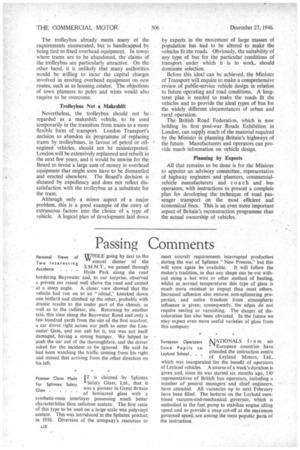Passing Comments
Page 20

Page 21

If you've noticed an error in this article please click here to report it so we can fix it.
WHILE going by taxi to the " annual dinner of the S.M.M.T., we passed through Hyde Park along the road bordering Bayswater and, to our surprise, observed a private car raised well above the road and canted at a steep angle. A closer view showed that the vehicle had run on to an "island, knocked down one bollard and climbed up the other, probably with drastic results to the under part of the chassis, as well as to the radiator, etc. Returning by another taxi, this time along the Bayswater Road and only a few hundred yards from the site of the first accident. a car drove right across our path to enter the Lancaster Gate, and our cab hit it, but was not itself damaged, having a strong bumper. We helped to push the car out of the thoroughfare, and the driver asked for the incident to be ignored. He said he had been watching the traffic coming from his right and missed that arriving from the other direction on his left.
Personal Views of Two Interesting Accidents . . .
IT is claimed by Splintex 'Safety Glass, Ltd., that it was a pioneer in Great Britain of laminated glass with a synthetic-resin interlayer possessing much better characteristics than cellulose acetate. The first resin of this type to be used on a large scale was polyvinyl acetate. This was introduced in the Splintex product in 1936. Diversion of the company's resources to
Pioneer Claim Made For Splintex Safety Glass. . . . . .
meet aircraft requirements interrupted production during the war of Splintex "New Process," but this will soon again be available. It will follow the maker's tradition, in that any shape can be cut without using a hot wire or other method of heating, whilst at normal temperatures this type of glass is much more resistant to impact than most others. Increased adhesion also ensures non-splintering properties, and entire freedom from atmospheric influence is given; consequently, the edges do not require sealing or varnishing. The danger of discoloration has also been obviated. In the future we may expect even more useful varieties of glass from this company.
NATIONALS from six
European countries have attended the instruction centre of Leyland Motors, Ltd., which was inaugurated for the benefit of operators of Leyland vehicles. A course of a week's duration is given and, since its was started six months ago, 140 representatives of British bus operators, including a number of general managers and chief engineers, have attended. All vacancies up to next February have been filled. The lectures on the Leyland combined vacuum-and-mechanical governor, which is embodied in the fuel pump to stabilize engine idling speed and to provide a snap cut-off at the maximum governed speed, are among the most populEir parts of the instruction.
Send Pupils to Leyland School . . . Cab and Driver Take a Trip by Aeroplane and Save Petrol . .
TOURING America is a A 'Bristol Freighter, a n d recently a cab driver took Captain " Tim " Sims of that aircraft and his crew from San Francisco to Oakland airport, where the Bristol was then located. The Captain, having learned that the cabby wOuld have to make a return trip empty to San Francisco, loaded both driver and vehicle into the aircraft and flew them there. It happened to be the driver's birthday, and he remarked that it was a " swell " present, also that it saved him 35 cents in bridge toll, as well as fuel and wear and tear on the cab Studying Maintenance (IN the forward control Problems—An Albion I."'" Albion CX models, the Device 6-7-tonner, six-wheelers and eight-wheelers, the sheetmetal dash is now made in three sections, the outer parts being mounted on dash irons The centre portion, including the front cowl for the top of the bonnet, is made as a detachable unit. The purpose of the new arrangement is to facilitate the use of a jib crane for lifting out the engine after removing the radiator. The latter operation is particularly simple, the radiate' being mounted on two horizontal supporting bolts between thick rubber washers, the whole being held by a nut at each side.
Distinguishing BeOR a layman to distinguish tween Motorbuses and between a motorbus and Trolleybuses at Night a trolleybus, after dark, is not altogether easy. London Transport is assisting the public in this direction by fitting destination-indicator blinds with blue lettering to all trolleybuses operating from Hounslow Garage. In the past, blue bulbs have been used behind blinds with white lettering, whilst motorbuses have been fitted with normal light bulbs. As the supply of blue bulbs is restricted, blue lettering is being adopted as an alternative and is illuminated by normal colourless bulbs.




































































